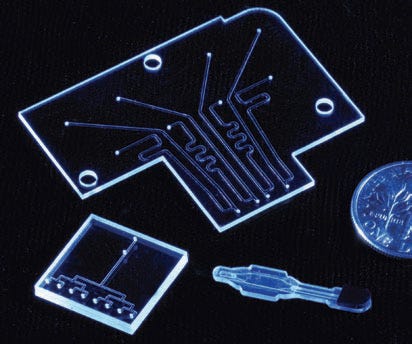Event coverage of MD&M West 2011
February 2, 2011
|
Microfluidic technologies are suited for single-use devices that provide sample-to-answer functionality. |
Leanna M. Levine, president and CEO of ALine Inc. (Rancho Dominguez, CA), will present "Design and Development of Sample-to-Answer Microfluidic Disposables for Point-of-Care Applications" on Wednesday, February 9, 2011. The session will take place at 1 p.m. at Innovation Briefs Theater 1.
MPMN: How has microfluidics impacted medical device design and development?
Levine: Early microfabrication technologies used in research and development, such as microinjection molding, embossing, and etching in silicon or glass, are expensive to use for commercial product development and risky to implement in molecular and immunodiagnostic product manufacture for a couple of reasons.
Fabrication in glass or embossing in plastic is generally not compatible with high-volume manufacture of a single-use product for the diagnostics market. Microinjection-molded components are economical at high volumes--hundreds of thousands to millions of devices per year, depending on cost per test--because they require a significant investment in tooling. Products manufactured with such mass-production technologies would be expected to address large markets. Products that address smaller, niche markets justify neither large development nor tooling costs nor the time delays associated with such methods.
A novel technology platform like polymer laminate technology (PLT) offers lower development costs and shortens the design-build-test cycle because it does not require tooling, facilitating iterative, empirical testing of fluid components. With care in the development of a robust and repeatable fabrication process, polymer laminates are readily scalable to support development, clinical trials through to product launch, and volume manufacture. The equipment and processes in lamination are ubiquitous and well established, ensuring a path to volume manufacture without specialized manufacturing equipment. For microdevice fabrication, tools and processes familiar to other industries such as printed circuit board manufacture and lamination are used in a new way, with proprietary processes developed to address the unique aspects of microfluidics. For scale-up to volume manufacture, the development costs are reduced, and risk is lowered because the path to volume manufacture is well understood.
The advantages of microfluidics support the needs of modern diagnostics by offering faster separations, shorter transport time, lower sample and reagent consumption, and the possibility of multicomponent testing under the same conditions. Microfabrication technologies have taken diagnostics from single, highly complex tests that are performed in traditional diagnostic labs and take two to three days to render results to near-patient panels that provide results in mere minutes to hours. These near-patient tests are designed to be as user-friendly as possible, requiring the simple addition of a sample while the device does the rest of the work. With remote healthcare on the horizon, such simplicity will be required for personalized medicine or to assist in patient compliance to therapeutic regimens. Thus, the need for complex microfluidic components and advanced microfabrication technologies like PLT increases.
MPMN: What will you discuss in your presentation?
Levine: My discussion will cover microfluidic technologies and how they are suited for single-use devices that provide sample-to-answer functionality. Two hurdles have limited the development of products: the high cost and long lead time for prototyping and the high cost of amortizing tooling for a product whose initial sales volumes are typically less that 250,000 parts per year. The first hurdle means that not only is the cost of prototyping very high, but the design-build-test cycle can take months. The second hurdle means that the initial cost-per-piece price of the product will be too high, and no profits can be realized. This limits the products that can serve important but more niche markets.
I will also discuss a complement to traditional approaches such as injection molding and die-cutting, known as PLT, and its benefits to the medical diagnostics market. This enabling platform has been shown to support the development of a new molecular diagnostic product from early prototyping to product launch and provide low-volume manufacture. Examples of custom product development discussed will demonstrate the ease of use of this platform. We will discuss expected price points for manufacture with this technology, as well as the path to volume production.
MPMN: What do you hope attendees will learn from your presentation?
Levine: The goal is for attendees to become more aware of the newest prototyping technologies available and how they will propel the future of point-of-care, sample-to-answer devices. Point-of-care testing continues to drive the future of healthcare delivery by improving test-result turnaround time and proper prescription of medications. The faster the delivery of test results, the greater the efficacy of the diagnostic device and testing. Microfluidic systems should therefore be designed to provide test results with this in mind. Microfluidic devices provide easy integration with optical and electrochemical sensing in a small, compact platform that preserves workflow in a clinical setting. The challenge now is creating these devices with lower development costs and shorter development times. New technologies like PLT exist that can provide this.
You May Also Like



